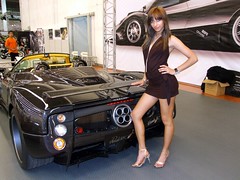The Pagani Zonda will go down in history as one of the greatest automobiles ever made. It’s immeasurably gorgeous, superlatively fast, unique, impeccably designed and built -- and it was probably one of the last supercars that didn’t focus on the numbers. But any good thing -- even any great thing -- must come to an end. And the end has come for the Zonda. It’s gone through quite a life -- originally debuting with a 408 horsepower 6.0L Mercedes V12 in 1999, all the way through the scarcely-related Zonda R track car with it’s CLK-GTR engine, carbon-titanium chassis, and what are widely considered to be the sexiest headers on earth.
But frankly, 12 years is about two lifespans for any car -- even one as fantastic as the Zonda. What used to be a rocket-fueled flight of fancy, something of a UFO with a numbertag and insurance docs, well -- it’s not as magical as it used to be. The Zonda has become something of a standard bearer in the supercar market, a point of reference. I get the impression that Horatio Pagani is not the type of man that rests on his laurels, or enjoys having his creation considered a fixed entity. Thus, the Huayra.
First things first -- what is a Huayra? Well, as a matter of fact, it’s named after the Andean God of the wind -- Aymara Huayra Tata. That makes sense, considering the Zonda was named after an air current above Argentina (not a fruit crate.) Perhaps they teamed up with VW’s notorious “finding hard-to-pronounce-names” department? But a supercar should have a super name. There’s no fun in telling someon you drive a 599GTB HGTE F1. Now, Huayra? We’re in business.
Stylistically, it’s obviously related to the Zonda in it’s general shape and dimensions, but there’s a softness of form to the Huayra that was conspicuously absent from the Zonda. There were a lot of angry, flat surfaces punctuated by dramatic angles on the Zonda -- it’s more smooth, flowing, organic with the Huayra. Initial internet haters, who will likely never touch a Huayra in their god-given life, liked the Huayra’s shape to that of a Catfish. Well, “haters’ gonna hate.” I think it’s gorgeous. I’m frankly a bit tired of overstyled Flash-Gordon supercars anyway. Oh, and: Gullwing doors!
Now, performance has always been the hallmark of Pagani’s creations, and the Huayra takes that bar… and raises it up a few feet. We’re talking crazy, bring-extra-underwear, weapons grade power here. Most importantly, the Huayra is light. Very light. A few points of reference: a Veyron Super Sport crushes the scales to the tune of 4,052lbs. A Lamborghini Murcielago LP-640 weighs in at 3,671lbs. The Huayra? 2,976 pounds. This is lighter than my four-cylinder Accord. This is about the same weight as my 22-year-old 900 Turbo with no safety equipment. The secret is the construction materials: the Huayra sits atop a monocoque space-frame made out of the carbon-titanium mix that first appeared in the Zonda R. And the body panels are all carbon-fibre as well.
| Power | Weight | Power:Weight Ratio | |
| Pagani Huayra | 700bhp | 1350kg | 1.93kg/bhp |
| Veyron Super Sport | 1183bhp | 1838kg | 1.55kg/bhp |
| Murcielago LP670-4 SV | 661bhp | 1565kg | 2.37kg/bhp |
| Ferrari 599 GTO | 661bhp | 1605kg | 2.43kg/bhp |
| Corvette ZR-1 | 638bhp | 1515kg | 2.37kg/bhp |
| Lexus LFA | 552bhp | 1480kg | 2.68kg/bhp |
| Porsche 911 GT2RS | 612bhp | 1370kg | 2.24kg/bhp |
To put that craziness into more US friendly terms, each horsepower under a Corvette’s hood is carrying 5.24 pounds along for the ride. Each horsepower under a Huayra’s clamshell is carrying 4.25. Whoa.
Hooked up to this twin-turbo bent-twelve is a brand new 7-speed sequential gearbox with a dual-disc clutch, supplied by racing gearbox manufacturer Xtrac -- who also supplied the ‘box for the Zonda R.
The suspension is all-new, utilizing Ohlins dampers in a pushrod-style suspension arrangement. To be honest, the Italian-English translation of the Huayra’s press release leaves something to be desired, but I did catch something about cooling ducts running to the wheel bearings (huh?) and that the uprights were 30% lighter than traditional Aluminum ones, which makes me wonder if they’re made out of Unobtanium. Or maybe Unununium?
But undoubtedly the coolest thing about the Huayra are the active aerodynamic aids. The car has four constantly adjustable aerodynamic flaps that vary their angles by yaw and pitch sensor data to optimize downforce and drag for whatever the car is doing. We’ve moved light-years from the old-school “bolt a spoiler to it” ethos. Remember the Countach’s outlandish wing? You had the choice between having the wing bolted to the car, and handling that was predictable at high speeds but a lower top speed due to drag… or no spoiler, a faster top speed, and frankly terrifying handling. This is to aerodynamics what the new 9-5′s crazy-adaptive headlights are to lighting.
So, the Huayra is gorgeous. It’s also a superlative performer, with Pagani claiming a 230mph top speed. It’s also in the running for most amazing automotive interior ever created. Just look at this: exposed gearshift linkage, orange leather, chrome… ahh goodness. A picture’s worth a thousand words.
Pagani released a whole slew of pictures but not a whole lot more technical data on the Huayra, so we get to play the waiting game for more juicy details. No pricing has been announced, but it’s safe to assume that if you have to ask you can’t afford it, or probably even afford a wheel for it. A price of an even £1M would be a good bet. Stay tuned for more details.





















